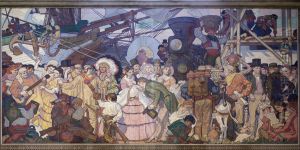Dean Cornwell Paintings
Dean Cornwell, born on March 5, 1892, in Louisville, Kentucky, was an American illustrator and muralist renowned for his prolific work in the early to mid-20th century. Cornwell began his artistic career at the age of 18, studying at the Art Institute of Chicago and later under Harvey Dunn at the Grand Central School of Art in New York City. His early work included illustrations for popular magazines such as 'Harper's Bazaar,' 'Redbook,' and 'Good Housekeeping.'
Cornwell quickly became recognized for his distinctive style, characterized by dramatic lighting and vivid storytelling. During the 1920s and 1930s, he was considered one of America's leading illustrators. His illustrations graced the pages of major publications, and he was often commissioned for advertising campaigns, book illustrations, and war propaganda posters during World War I and World War II.
In addition to his illustration work, Cornwell was highly respected for his large-scale murals, which can be found in public buildings across the United States. Notable mural works include those at the Los Angeles Public Library, the New York General Motors Building, and the Raleigh Hotel in Washington, D.C. His murals often captured significant historical moments and were celebrated for their intricate detail and grandeur.
Beyond his commercial success, Cornwell was an influential figure in the art community. He served as the president of the Society of Illustrators and played a crucial role in elevating the status of illustrators as professional artists. Despite the decline in traditional illustration work with the rise of photography in advertising, Cornwell remained active in the art scene until his later years.
Dean Cornwell's contributions to American art were recognized with numerous awards and honors throughout his career. His legacy is preserved through his enduring works and his impact on a generation of illustrators and muralists. He passed away on December 4, 1960, leaving behind a rich body of work that continues to be studied and admired for its artistic excellence and historical significance.
